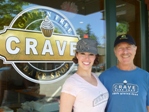
Gluten-Free Leadership
Here are recipes for leaders who wish to mix, then bake the strongest possible performance in themselves and others.
- By Robert Pater, Kyra Bussanich
- Aug 01, 2011
Kyra Bussanich is a nationally acclaimed gluten-free pastry chef with Crave Bake Shop (www.cravebakeshop.com).
Many people are discovering that in what they ingest, very small particles can make a big difference in their health and well-being. And the same is true for safety leadership.
You likely know those with peanut allergies can have severe reactions to even a tiny exposure. But did you also know that an even more pervasive food provokes negative reactions in a much larger populace?
Gluten (meaning "glue" in Greek) is a plant protein found extensively in wheat, barley, rye, and spelt and can masquerade as other substances, such as MSG, maltodextrin, malt vinegar, glucose, and more. According to the Centers for Disease Control and Prevention, autoimmune diseases (Celiac Disease, Crohn's Disease, Hashimoto's, etc.) affect 5-7 percent of the population -- and this percentage is significantly rising, especially with aging populations. Many affected react violently to even the smallest amount of gluten; for the most sensitive, one particle of gluten can have lasting repercussions.
Then there are people who, rather than suffering a diagnosed disease, are gluten intolerant, yet still experience pronounced effects. For them, eliminating this substance can reduce chronic migraines, swollen and painful joints, or can't-kick-it fatigue.
And there's another set whose peak performance is gluten impaired. For example, a May 16, 2011, Wall Street Journal article profiled tennis pro Novak Djokovic, who "conquered the tennis world" after discovering an allergy to gluten, then eliminating it from his diet. A very good performer transformed, almost instantly, into a great one, beating court legends Roger Federer and Rafael Nadal (the latter without losing a set). Djokovic and others credit his startling improvement to avoiding gluten.
Even if you don't have gluten tolerance issues now, it's a good bet you know someone who does or that you've seen a growing presence of gluten-free products in restaurants or supermarkets. But do people actually like these foods or just reluctantly select this diet (or worse, disregard it, eat what they know can harm them)?
"Gluten-free" desserts -- or leadership -- don't have to be bland or taste like sand; in fact, such cooking can result in delectable pastries. Similarly, here are recipes for leaders who wish to mix, then bake the strongest possible performance in themselves and others.
- Remember that just because you can't see it doesn't mean people aren't affected. Best leaders bear in mind there may be problems that are invisible yet still adversely affect safety and productivity. They unearth these by asking, watching, and listening, rather than assuming that what's obvious is all there is.
- Small, daily "ingestions" may create significant irritants. We know this certainly is the case with strains and sprains, where common everyday actions -- such as overreaching to switch off a light, bending over empty-handed when off balance, and much more -- can mount into disabling cumulative trauma injuries. The best leaders fine-tune their radar to scan for small issues that might otherwise build into pathogenic problems. Watch for and reduce hidden sources of reactants, such as not actively supporting change initiators, ignoring well-intentioned suggestions, or periodically targeting a person or group as an ongoing butt of disparaging jokes.
- Sometimes solutions come from adding fewer rather than more ingredients. Attuned leaders think small as well as big, reduce the little blockages, as well as mixing in the right large changes. They employ both sides of their larder -- incorporating needed interventions while simultaneously reducing or eliminating irritants that block safety and organizational well-being. Just as adding a pinch of the wrong spice can throw off a pastry's taste, we've seen relatively small obstacles (e.g., contracting delays, calendar inaccessibility, reporting confusion) get in the way of higher-level performance.
- Assume and allow for individual adverse reactions. Remember that some people react strongly to small changes that don't seem to disrupt others. Sure, the majority of people may process gluten without apparent difficulty, but with a large group to feed, wouldn't it be wiser to plan for sought-after gluten-free options that everyone could safely eat? Similarly, though only 10 percent of the population is left-handed, doesn't it make more ergonomic sense to design machine controls to be side-switchable to accommodate all workers, including those you might not realize are left-handed?
- Recognize what adversely affects people can change over time. Gluten exposure can trigger Celiac Disease in people later in life, even in those who previously hadn't shown sensitivity. So while do-it-or-terrible-things-will-happen messages might have motivated workers in the past, these may not prove effective or even backfire after the fifth or tenth iteration (especially with experienced, seen-it-all staff).
Be sure to continuously reassess your workforce to adjust for changes in aging-related mental and physical safety concerns. Repetitively lifting small weights might not show harm to younger workers; fast forward 10 or more years, and equally light loads may break down these same staff.
We know some people think of gluten-free cooking as a turnoff, equate it with being flavor-free. But creative baking leaders can turn out exquisite pastries that even gluten-full people will seek out. And well-baked strategies need not result in weak, overly-cautious, do-nothing leadership. The key is to plan for diverse reactions and tailor tasty communications for all.
In gourmet baking, every ingredient is critical and has to chemically fit with all others. The same is true for highest-level organizational leadership, especially in these waste-not-want-not times. Leaders can bake their cake and have everyone eat it, too, by adopting the principles of planning and communicating "gluten-free."
This article originally appeared in the August 2011 issue of Occupational Health & Safety.